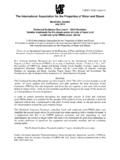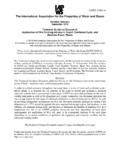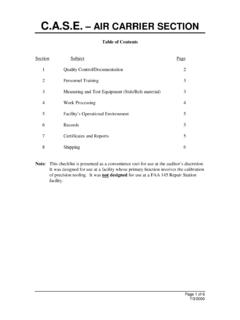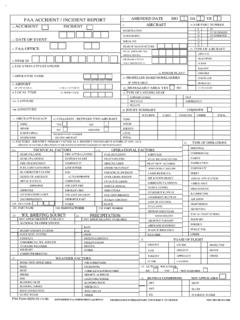Transcription of The International Association for the Properties of Water ...
1 IAPWS TGD4 11(2015) The International Association for the Properties of Water and Steam Stockholm, Sweden July 2015 Technical Guidance Document 2015 Revision: Phosphate and NaOH treatments for the steam- Water circuits of drum boilers of fossil and combined cycle/HRSG power plants 2015 International Association for the Properties of Water and Steam Publication in whole or in part is allowed in all countries provided that attribution is given to the International Association for the Properties of Water and Steam Please cite as: International Association for the Properties of Water and Steam, Technical Guidance Document: Phosphate and NaOH treatments for the steam- Water circuits of drum boilers of fossil and combined cycle/HRSG power plants (2015). This Technical Guidance Document has been authorized by the International Association for the Properties of Water and Steam (IAPWS) at its meeting in Stockholm, Sweden, 28 June to 3 July, 2015.
2 The members of IAPWS are: Britain and Ireland, Canada, Czech Republic, Germany, Japan, Russia, Scandinavia (Denmark, Finland, Norway, Sweden) and the United States of America. Associate Members are Argentina and Brazil, Australia, France, Greece, New Zealand, and Switzerland. The President at the time of adoption of this document is Dr. David Guzonas of Canada. Summary This Technical Guidance Document was first issued in 2011. This 2015 revision includes a small number of minor updates and clarifications, and adds guidance for Heat Recovery Steam Generators (HRSGs) that start frequently and those that are required to fast start with minimal delays to startup times. These do not constitute significant changes to the scope of the document or to the guidelines for normal operation. This Technical Guidance Document considers fossil and combined cycle/HRSG plants and identifies the normal target values for each plant type when operating with a phosphate or NaOH (caustic) treatment.
3 It is emphasized that this is an IAPWS technical guidance document and that, depending on local requirements, the normal or target values will need to be customized for each plant depending on the actual conditions of operation, the equipment and materials installed, and the condenser cooling media. This Technical Guidance Document contains 37 pages, including this cover page. Further information about this Technical Guidance Document and other documents issued by IAPWS can be obtained from the Executive Secretary of IAPWS (Dr. Dooley, or from 2 Contents 1. nomenclature and Definitions 3 2. Introduction: Purpose of Document and How to Use it 5 3. Background to Corrosion in the Water /Steam Circuits of Power Plants 7 Chemical Conditioning to Minimize Corrosion 8 4.)
4 Descriptions of Chemistries (Phosphate Treatment (PT) and Caustic Treatment (CT)) 10 Introduction of PT and CT 10 Description of PT 11 Introduction to PT 11 Monitoring PT 13 Description of CT (NaOH Dosing) 14 Introduction to CT 14 Guidance for CT 15 Monitoring CT 16 5.
5 Tables of Chemistry Limits 16 Four Tables of Cycle Chemistry Limits 16 Normal Limits for PT and CT in Tables 1-4 17 Chemistry Limits for Requisite Parameters at Specified Locations 18 Development of Action Levels 18 Development of Shutdown Limits 19 Dealing with Condenser Leaks 19 6. Road Map Approach to Reach Optimum PT and CT for Fossil and Combined Cycle/HRSG Plants 26 Customization of Base Tables to Include the Effect of Drum Pressure 28 Customization of Base Tables to Deal with Different HRSG Designs 30 Customization of Base Tables to Deal with the Addition Level of NaOH 30 Customization of Base Tables to Deal with Phosphate Hideout and Hideout Return 31 Customization of Base Tables to Deal with Dryout and Circulation Problems 32 Customization of Base Tables to Deal with Addition of Chemicals into other than the Drum
6 33 Customization of Tables 1 and 2 to Deal with Different Feedwater Heater Materials 33 Customization of Base Tables to Deal with Condenser Leaks 34 Customization of Base Tables to Deal with Deposits 34 Frequently Started and Fast Start HRSGs 35 7. Bibliography and References 36 3 1. nomenclature and Definitions Term Alternative or Acronym Definition Acid phosphate Corrosion APC A boiler/HRSG under-deposit corrosion (UDC) tube failure mechanism where acid phosphates (di- and/or mono-sodium phosphate) concentrate beneath deposits All-volatile Treatment AVT AVT(R) AVT(O) Conditioning regime in which only volatile alkalizing agents are added to the feedwater (commonly ammonia, but volatile amines may also be employed) May be either.
7 Reducing conditions (added reducing agent) or Oxidizing conditions (without reducing agent) Attemperator Device for controlling superheater and reheater outlet temperature by spraying feedwater (or condensate or degassed demineralized Water ) into steam Caustic gouging CG A boiler/HRSG under-deposit corrosion (UDC) tube failure mechanism where NaOH concentrates beneath deposits Condensate Polishing Plant CPP System containing ion exchange resins to purify condensate. Can also include a filtration system Condensate Pump Discharge CPD Conductivity Specific Conductivity Direct Conductivity Electrical conductivity of the Water sample as measured directly without any treatment [1] Conductivity after cation exchange CACE Cation Conductivity Acid Conductivity Conductivity of a Water sample after passage through a strongly acidic cation exchanger in the hydrogen form Caustic Treatment CT Hydroxide Dosing Involves addition of NaOH to the boiler or HRSG evaporator Corrosion Fatigue CF Boiler/HRSG tube failure mechanism Degassed conductivity after cation exchange Degassed Cation Conductivity DCACE Conductivity after cation exchange of a sample from which volatile weak acids (predominantly carbonic acid)
8 Have been stripped Di-sodium phosphate DSP Dissolved Organic Carbon DOC A convenient measure of dissolved organic components in the Water or steam 4 Term Alternative or Acronym Definition Drum boiler Boiler in which steam (generated in heated evaporator tubes) is separated from Water in an unheated horizontal pressure vessel (drum). The liquid phase is recirculated to the evaporator. Economizer First heat transfer section in boiler or HRSG to heat feedwater located in the cold end of the plant Fast Start Combined Cycle / HRSG Plant Combined cycle plant able to have accelerated hot, warm and cold starts. Feedwater Water that is being pumped into a boiler or HRSG to balance the steam production Flow-accelerated Corrosion FAC Accelerated chemical dissolution of magnetite on the surface of carbon steel components in the feedwater system and HRSG evaporators, typically occurring at locations of turbulence in the flow Heat Recovery Steam Generator HRSG Plant that generates steam using heat transfer from the exhaust gas of a combustion (gas) turbine Hydrogen damage HD A boiler/HRSG under-deposit corrosion (UDC)
9 Tube failure mechanism where acidic conditions concentrate beneath deposits Makeup Water MU Water which is added to compensate for losses of Water and steam from the system Mono-sodium phosphate MSP NaH2PO4 Once-through boiler or HRSG Benson Boiler Boiler in which output steam is generated from input Water by complete evaporation. There is no recirculation of boiler Water . Oxygenated Treatment OT Combined Water Treatment, CWT Conditioning regime in which ammonia and oxygen are added to the feedwater Phase-transition Zone PTZ Region in low pressure steam turbine where superheated steam changes to moisture Phosphate Treatment PT Conditioning regime for drum boilers in which alkalinity is achieved by dosing tri-sodium phosphate to the boiler Water Preheater A circuit in an HRSG prior to the economizer and LP drum to preheat condensate Tri-sodium phosphate TSP Na3PO4 Total Organic Carbon TOC A convenient measure of total organic components in the Water or steam Under-deposit Corrosion UDC Boiler/HRSG tube failure mechanism, Three UDC mechanisms are: hydrogen damage (HD), Caustic gouging (CG) and acid phosphate corrosion (APC) Water Treatment Plant WTP Facility where high purity Water is prepared and stored 5 2.
10 Introduction: Purpose of Document and How to Use it Phosphate and caustic treatments are common forms of chemical treatments for drum boilers of conventional fossil plants and for the multi-pressure drums in combined cycle/HRSG plants. They are the subject of this part of the suite of IAPWS Technical Guidance Documents [2-4, 13, 16]. The purpose of this document is to provide guidance on the selection of the most appropriate chemical addition for these boiler/HRSG drums to provide maximum corrosion protection. The guidance can be used directly by chemists and plant operators, and to develop International , national, company, and manufacturer s guidelines. It should be noted that the feedwater treatments for these units have been published in another IAPWS Technical Guidance Document [2] and the Normal/Target values for feedwater in this document [Tables 1-4] in Section 5 remain the same.








![CHAPTER 329 [NEW] UNIFORM CONTROLLED SUBSTANCES …](/cache/preview/7/b/4/1/8/2/d/e/thumb-7b4182de407585aa85cfb3800e495276.jpg)


